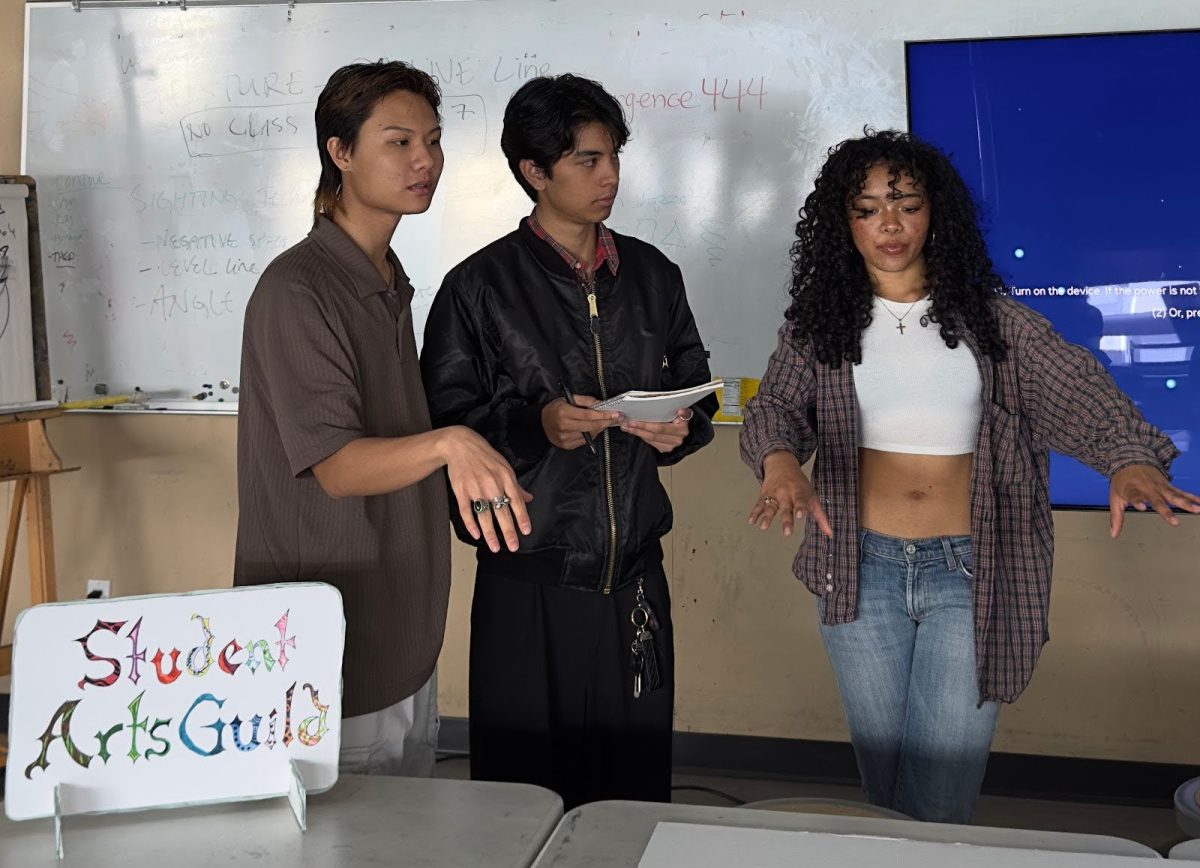
Surviving COVID-19 has become Mike Jones’ first concern. As a Berkeley City College student, musician and digital artist, his day-to-day struggles can’t be seen in his wide brown eyes, broad smile and cheerful voice — but he is more determined than ever to survive yet another hardship that has been thrown his way.
From a young age, Jones has struggled with unemployment, faced financial issues and hovered near the poverty line, but he never stopped fighting for his survival. Now stuck inside his Oakland apartment, he remembers the last time he faced such uncertainty. You wouldn’t know what he’s been through if Jones didn’t tell you.
In 2009, Jones moved to San Francisco, a city well known for its wealth, and he began looking for a job. He didn’t have enough money to rent a room, so he became a couch surfer, traveling from one friend’s apartment to another. Time went by, and weeks turned into months of job searching. Couchsurfing became his way of life. After six months of living with friends, he ended up on the street. With nowhere to go and without a roof over his head, he had only $500 to his name.
Jones never anticipated that the moment would arrive — the moment when he would sleep on city streets and benches in Golden Gate Park that became his bedroom. The showers at a local gym were his only bathroom.
“I survived, but the freezing weather was the hardest to cope with,” Jones said
Coping with unforeseen circumstances and homelessness, like Jones did, is all too common for many students in California. The March 2019 #RealCollege Survey, conducted in partnership with the California Community College State Chancellor’s office and the Hope Center, found that one in five California community college students are experiencing homelessness. The 40,000 students surveyed across 57 community college campuses also reported that they often struggle to pay rent and buy food.
After a month of living on the streets, Jones finally caught a break when he got a job in the service industry. Working at restaurants provided Jones shelter and a steady income for almost a decade. After a decade of stability, in January an unexpected reality hit him again: the restaurant where he worked as a shift manager shut down.
Facing unemployment again in his second semester at Berkeley City College, Jones found the courage to hunt for a new restaurant job, applying where he could and awaiting answers. In the meantime, Jones was still faced with bills that included his college tuition, his rent and other bills which totaled more than $1,000 a month.
As a new strategy, Jones decided to turn to a bicycle for salvation. He used this new mode of transportation to work as a bike courier for food delivery service Caviar, earning no more than minimum wage. Even with this new tech twist on employment, Jones’ salary has dropped substantially compared to what he used to earn: from $1,000 a week managing the restaurant to barely $300 as a bike courier.
The struggle to make ends meet might not be new for Jones, but the new complication is his fear that he will fail in his studies as he tries to balance his financial situation. This added complication is one that many students who work in the service industry are facing in the Bay Area, as the cost of living remains astronomical and the ability to make a livable wage has been impacted by COVID-19.
“I have pretty bad ADD [Attention Deficit Disorder], and I’m pretty overloaded this semester trying to balance work and school. My professors have been pretty understanding though,” Jones said.
Jones has been making motion graphics for music projects, and he has an interest in doing it for work. He had always dreamed of being an independent artisan, producing music, animation, and other art forms.
“I am a creative person, which happens to be a double-edged sword. I like making things on my own terms and my own pace…ideally, I’m looking for a job where I can sit, working remote from a mountain town with decent internet access,” Jones said.
Jones is well-known for being a creative and friendly person, said Chelsea Rathkamp, a classmate of Jones. She said that she admires him for the way he always supports her and for his ability to make everyone around him comfortable.
“I remember when we were in class together, he helped me edit my final project and made me feel confident navigating Premier Pro,” a video editing software, she said. Moreover, Rathkamp believes that Jones will have a successful career as an artist.
“He is a real wizard in the synths, and I enjoy his band very much. I know he is currently pursuing animation, and I’m certain he’ll create really interesting content. I think he’ll find levels in success in anything he pursues creatively,” Rathkamp said.

Amid troubles, Jones grapples with work-life balance. When six Bay Area counties began a shelter-in-place on March 16, Jones suddenly found himself cloistered by four walls, jobless and facing down the fear of the unknown. To exacerbate matters, Jones’ girlfriend Sky Cavallo La Rue, who was able to help cover expenses in the interim, lost her job in March. She was working as a hairstylist in a beauty center which shut down because of the virus.
“I am supporting and helping Michael the best that I can. Financially, I am fairly responsible,” Cavallo La Rue said. “Emotionally, I try to be as healthy as I can be in order to better aid and challenge him.”
Jones and his girlfriend aren’t the only ones affected by this crisis. The effect of COVID-19 has also hit Jones’ roommates, whom he depends on to pay rent for the four-bedrooms duplex they live in. Half of his roommates work in the food industry, while the rest — who work in construction — are also not able to make money because projects have stalled. Jones is the master tenant in the duplex where he lives — along with his seven other roommates who aren’t sure how they will come up with their $3,200 rent.
“I can’t imagine us paying rent on time this month. I’m looking at all the facts and graphs, and there is this alarming reality–things won’t go back to normal until August. Even if we can’t get evicted right now, we would need to catch up on four months of rent once this is all over,” Jones said.
Mike and his girlfriend have some savings that allow them to pay rent this month, but they are still dealing with uncertainty.
“The big issue is not whether or not we are going to be able to pay, but the uncertainty of how long this will last, ” Jones said, adding that the city eviction freeze provides a sense of relief, for now.
“I’m uncertain on what is going to happen once April 1 comes around, but I’m not too worried about it because there is an eviction freeze in California. So, I feel like whenever this is over, we can negotiate with our landlord on how to catch up,” Jones said.
Like many college students facing new economic realities because of the pandemic, Jones worries about how he will pay tuition, particularly because he is taking 12 units this semester, and if he will be able to finish his degree on time. Jones is nine units away from getting his animation degree, and he hoped to finish and get his degree by the end of fall. But due to his financial struggles, Jones is debating whether to switch to a free certificate program instead of finishing the associate’s degree, since he currently does not receive financial aid.
According to data from the California Community College State Chancellor’s office, Peralta had a fall 2019 student headcount of nearly thirty thousand students, with 6,711 students receiving the need-based federal Pell Grants during the 2018-2019 year at Peralta . Although Pell Grants are one kind of aid available, students can also qualify for and receive state and program support. For example, foster youth attending college may qualify for NEXTUP services and resources, or recent California high school graduates could be eligible for the California Promise. Aid qualifications based on income and other labels can be a barrier for students like Jones who don’t fit into a specific “box.”
“I am going for my Animation certificate. So far all my courses are holding up; I was hoping to finish up in fall, but that is completely contingent on what classes are available during summer,” Jones said.
The only thing left for Jones and his girlfriend to do is to file for unemployment and to dip into savings, but this difficult ordeal does not appear to be affecting Jones’ relationship. Jones’s girlfriend says they both continue to support each other and maintain a strong partnership.
“I support us both financially and he supports us in other ways. He is a great cook…he is the kindest person I’ve dated, he is a fun loving and free spirited person. Michael is considerate and reassuring to me always.” Cavallo La Rue said.
He’s taking advantage of the situation to spend more time with his girlfriend and enjoys working on his YouTube channel. Jones also keeps some hope for the future: “I’ve got future plans — and that has given me some peace. First step is first: catch up on homework during this break from reality.”
As he continues to put his situation into perspective and reflect on his past, Jones won’t allow this unexpected twist in his path to stop him. Focusing on his music and career aspirations, he radiates positivity.
“I am going to survive one way or another. I survived being homeless during the Great Recession.”

























